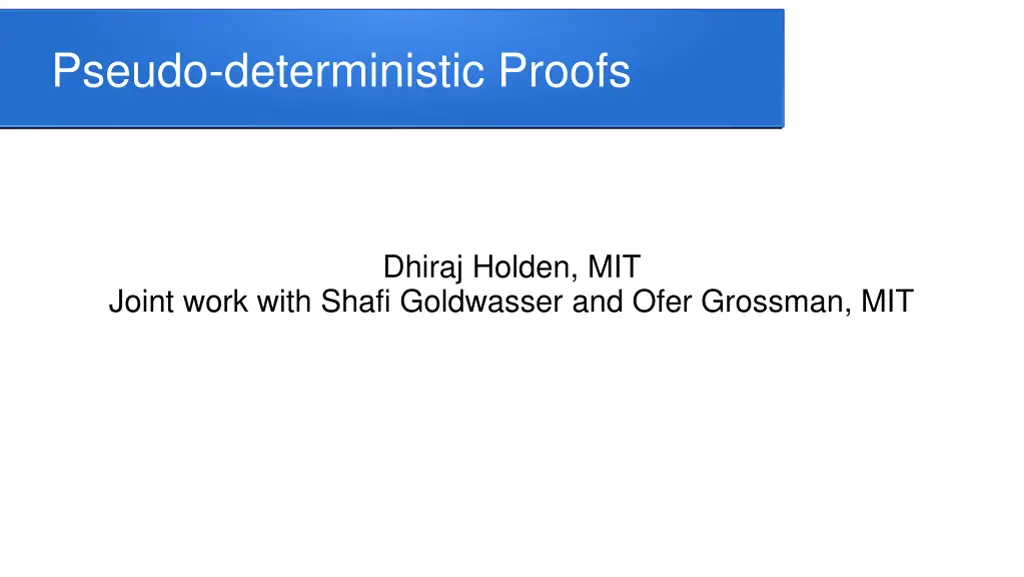
Pseudo-Deterministic Proofs and Search Problems
Explore the concept of pseudo-deterministic algorithms in search problems, showcasing examples and subsequent research in the field. Delve into pseudo-deterministic interactive proofs and their implications for canonical answers with high probability.
Uploaded on | 0 Views
Download Presentation

Please find below an Image/Link to download the presentation.
The content on the website is provided AS IS for your information and personal use only. It may not be sold, licensed, or shared on other websites without obtaining consent from the author. If you encounter any issues during the download, it is possible that the publisher has removed the file from their server.
You are allowed to download the files provided on this website for personal or commercial use, subject to the condition that they are used lawfully. All files are the property of their respective owners.
The content on the website is provided AS IS for your information and personal use only. It may not be sold, licensed, or shared on other websites without obtaining consent from the author.
E N D
Presentation Transcript
Pseudo-deterministic Proofs Dhiraj Holden, MIT Joint work with Shafi Goldwasser and Ofer Grossman, MIT
Pseudo-determinism[GG11] A pseudo-deterministic (psd) algorithm is a randomized algorithm for a search problem that on the same input outputs the same output (we will call it the canonical answer) with high probability Different than guaranteeing a unique answer [LD08] Reproducibility Correctness Amplification
Search problems Search problem: Given a relation R and an x, find a y such that (x,y) R or say that no such y exists Search-BPP is the class of search problems such that given x can find y such that (x,y) in R can be found in BPP.
Examples in Prior Work [GGR12] Sublinear pseudo-deterministic algorithms [GG15] pseudo-deterministic NC algorithms for bipartite matching [OS16] a sub-exponential time psd algorithm for finding a prime of length n on input n, that works for infinitely many input lengths
Subsequent Work [H17] gives an average-case result about pseudo- deterministic algorithms for search-BPP [GL18] proves that logarithmic space has repeatable randomized algorithms given a logarithmic number of bits
Today: Pseudo-deterministic Interactive Proofs In this talk, we will consider what happens when there is a powerful prover to help a polynomial time verifier to find a canonical answer y per input x so that: An honest prover can enable the verifier to output the canonical answer y with high probability over verifier s coins No cheating prover will be able to make the verifier output a different answer than the canonical one with high probability in addition to the standard notion of soundness
Pseudo Deterministic Interactive Proofs Let R be a relation and LR : x s.t. y s.t. R(x,y)=1 Verifier V Input: x Prover P Output Solution y or rejects Completeness : x in LR P s.t. Pr[V output y s.t. R(x,y)=1] >2/3 Soundness: x not in LR for all P , Pr[V rejects x]>2/3 CANONICAL: x in LR y for all P : Pr[Verifier outputs y y] <1/3
Application: Generating parameters for cryptographic systems Central authority (NIST) wants to choose a common cryptographic parameter on size n, but is untrusted Use pseudo-deterministic interactive proofs to verify that NIST generated a canonical cryptographic parameter Example: NIST picks prime p, generator g 8
This is different than Unique-SAT: In Valiant-Vazirani [VV], a number of instances are generated, one of which has a unique solution with high probability Single Valued NP functions: Examined by Hemaspaandra, Naik, Ogihara, and Selman [HNOS] is a deterministic version of pseudo-deterministic interactive proofs
Easy: The Unbounded-round Case For any search problem in PSPACE where the answers are polynomially bounded, finding the lexicographically first answer is in PSPACE Since IP = PSPACE, an unbounded-round interactive proof can give the lexicographically first answer to the verifier and convince the verifier with high probability
Pseudo-deterministic AM A relation R is in pseudo-deterministic AM (psdAM) if there is a function f(x) such that either f(x) = or (x,f(x)) R, and there exists a verifier V such that Pr[ z V(x,z) = f(x) ] 2/3 Pr[ z V(x,z) = f(x) or ] 2/3 Note that everything that is true for AM is also true for psdAM; constant rounds = 2 rounds public-coin = private-coin
PsdMA (bounded rounds) We say that a relation R is in pseudo-deterministic MA (psdMA) if there is some f(x) such that either f(x) = or (x,f(x)) R, and some V such that There exists z such that Pr[ V(x,z) = f(x) ] 2/3 For all z, Pr[ V(x,z) = f(x) or ] 2/3
Our Main Results: the bounded case A constant-round psdAM protocol for finding an isomorphism between two graphs More generally, Search-PAM coAM is in psdAM Vice versa, psdAM is in search-Ppromise-AM coAM (similarly for MA) No NP-complete problem can be in psdAM unless the polynomial hierarchy collapses Give a psdMA algorithm with subexponential-time verifier for all of search-BPP
Pseudo-deterministic graph isomorphism Show a protocol where on input (G0,G1) the verifier guarantees that it receives the lexicographically first isomorphism between G0 and G1, assuming that one exists (if an isomorphism does not exist the algorithm easily checks that and returns ) Idea: The protocol computes the lexicographically first isomorphism vertex-by-vertex (in parallel) For illustration, verifier uses private coins
On input G0=(V,E), G1=(U,E) Perform all stages in parallel Say the correct (vi)already established for 1 i k-1 Stage k: Prover claim (vk)=ur For every vertex s<r: Prove graph non-isomorphism of (D1,D2) where D1:Label v1 vk in G0 D2:Label (v1) (vk-1) us as 1 k in G1 Non-isomorphism proof Graph non-isomorphism [GMW, GS] is in AM
The Main Theorem Search-PAM coAM is in psdAM psdAM is in search-Ppromise-AM coAM This is also true for AM replaced with MA
The Main Theorem: part 1 search-PAM coAM is contained in psdAM q1,a1,q2,a2, ,qk,ak Interactive proof to show a1, a2, , ak are correct for q1, ,qk Verified by running search- P algorithm with answers a1, a2, , ak
Proof of the Main Theorem: Part 2 Claim: psdAM is contained in search-Ppromise-AM coAM To simulate psdAM on input x: ask the oracle Is the ith bit of the canonical answer to the psdAM interactive proof a 1? and use the answers to obtain y such that R(x,y) holds This problem is a promise problem in AM coAM since: there is only an answer when a canonical answer exists when no such answer exists it is undefined
Subexponential psdMA for search- BPP Subexponetial-time psdMA allows the verifier subexponential time We show that search-BPP is in subexponential-time psdMA To do this we observe there exists a hard function f in subexponential-time MA coMA that does not have poly- size circuits
Subexponential psdMA for search- BPP Truth-table tt(1, ,k) of hard function f and Witnesses w1, w2, , wk for f Check tt is accurate using w s Use tt to construct PRG G [NW94] Run search-BPP machine with randomness G(s1), G(s2), ,G(sj) on all seeds Output the first answer found
Open Problems Does there exist a psdAM protocol for every problem in TFNP? Can we find approximate short vectors in lattices in psdAM Can we find a prime p for a given length in psdAM? (The main issue here is how can the prover prove that the prime is canonical in some way?)











